Pathetic apology: sorry, nothing today: computer chaos and a looming deadline kiboshed any reading/pontificating. Normal service resumes tomorrow.
Dracula

Adapted by Otto Binder & Craig Tennis, art by Alden McWilliams (Ballantine Books)
No ISBN: U2271
You’re never to young to be exposed to the classics or scared out of your wits, and this delightful remnant from my own far-distant youth always brings back the gory, glory days of Bela Lugosi on TV and trying to sneak in to the latest Hammer Horror at the pictures (too young, not too cheap!) as well as such diverse treats as Famous Monsters of Filmland and other assorted illicit thrills that made we baby-boomers such terrific well-rounded, fully-socialised individuals.
At a time when scary movies, as well as Super-Spies, superheroes and comics in general, were all experiencing a popular revival, lots of strips made the jump to paperback format as publishers courted new markets. Along with lots of Mad collections, newspaper comic-strips, resized black and white comicbook reprints (such as High Camp Superheroes) and a host of other retreads, the occasional all-new item appeared.
One such is this delightfully forthright, faithful and respectful – if tension and terror free – adaptation of Bram Stoker’s gothic classic, adroitly encapsulated by comics and pulp sci fi legend Otto Binder (and Craig Tennis – of whom I know almost nothing other than he was a TV scripter) and drawn by the “deserves-to-be-legendary†Al McWilliams, a superb comics illustrator and draughtsman often confused with and nearly as good as his near-namesake Al Williamson.
The story is as you remember it; effective and pretty rather than beautiful and terrifying, but for a little seven year old it was a treasured item to be pored over, traced and adored, and today’s film fans might be enticed by Christopher Lee’s voluble introduction.
Even though it was reprinted by Manor Books in 1975, I suspect this isn’t the easiest of books to find, and to be completely honest the alternating portrait and landscape layouts make reading it a bit of a juggling act, but still and all I wish somebody somewhere would rescue this little gem from near obscurity. Any opportunistic publishers listening out there?
© 1966 Russ Jones Productions.
Giraffes in my Hair: a Rock ‘n’ Roll Life

By Bruce Paley & Carol Swain (Fantagraphics Books)
ISBN: 978-1-60669-162-6
Biographies are usually about interesting people and/or interesting times. Or at least famous ones. That makes this fascinating new book relating the incredible life-on-the-edge of ordinary hippie Bruce Paley an engrossing double-threat. Paley isn’t a superstar, he’s just a guy who turned 18 during the Summer of Love, bummed and scammed his way across America, saw some bands, met some girls, narrowly dodged the Draft and had a few memorable experiences along the way.
Captivatingly illustrated by Paley’s partner Carol Swain in her trademark monochrome line and textures style, we see his highs and lows: life as heroin addict, hookers and Black Panthers, getting by in crappy jobs, following the ever-changing music scene and even the rare brushes with real fame we’ve all experienced: in this case a short, intense friendship with doomed rock star Johnny Thunders.
Paley isn’t a particularly likable guy, but he and his life are real and human and worth recording – and this small saga of someone surviving some of our most turbulent times is a magical testament to creativity, durability and human adaptability. This is a captivating story and a brilliant use of our medium…
© 2009 Bruce Paley and Carol Swain. All rights Reserved.
Priscilla Darling

By Maz (Humorbooks)
No ISBN:
This little gem is a relic from a simpler time (although a quick scan of the internet reveals it to be still delightfully popular and readily available) when innocent smut was good, solid business, and genteel ribaldry could be infinitely double entendred for gentle laughs. Priscilla’s tale is the slight saga of an innocent English girl of good character and solid breeding who leaves her decent, upstanding family to go in search of happiness; becoming a very modern miss after illuminating encounters with “Ban the Bomb†marchers, soviet spies, Arab slavers, Hindu gurus, Eton-educated cannibals, assorted bandits and the good old British Navy.
This type of tale was very popular in the 1960s as cautious publishers tentatively acknowledged the zeitgeist of the times by not so much “Swinging†as “Gently Swayingâ€, but the real appeal of this still marvelously funny book is the copious vignettes, cartoons and saucy illustrations by the author: Dutch master storyteller, film-maker, draftsman and cartoonist Alfred Leonard Mazure who worked in Britain under the pen-name Maz.
Self-taught, Mazure (1914-1974) began his career in the Netherlands in 1932 with The Chef in Nieuwe Utrechtse Courant and De Prins, before embarking on a six-year journey of discovery through Europe and Africa. On his return to Holland in 1938 he created the seminal martial arts detective strip Dick Bos, best known to older fans and cognoscenti for their unique packaging (7cm broad and 11cm high {3″ x 4″} pocket sized digests).
Maz was the victim of an appalling, draconian contract in his own country, and remained anonymous and underpaid before moving to England after the War, where he gained a certain degree of fame and success with newspaper strips such as Dad and Egbert in John Bull and Passing Show, Sam Stone and Bruce Bunter in The Daily Herald (1948 to 1950), the brilliant adventure comedy Romeo Brown in The Daily Mirror (from 1954 to 1957 when he left the strip to the even more gifted Jim Holdaway), Jane, daughter of Jane – also in the fabulously comics-friendly Mirror – from 1961 to 1963 and Lindy Leigh for “top-shelf†men’s magazine Mayfair from 1969 to 1970.
Produced at the beginning of the 1960s sexual revolution, Priscilla Darling is a book crafted for an adult audience that probably knew less about sex and relationships than the average nine year old these days, but it’s undoubtedly a true guilty pleasure for anybody who can remember chaste kisses, the thrill of pursuit and the (far too) occasional coy and joyous surrender, anybody who yearns for beautifully rendered, sexually simpler times and anyone with an undying love of great cartooning.
© 1964 A. L. Mazure. All rights reserved.
Requiem Vampire Knight Tome 2: Dracula and The Vampires Ball
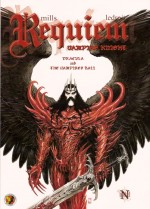
By Pat Mills & Ledroit (Panini Books UK)
ISBN: 978-1-84653-438-6
The second double compilation of Pat Mills and Olivier Ledroit’s darkly spectacular masterpiece of nihilistic anti-heroism intensifies the decadent horrors with the next two translated volumes that created such a storm when first released in France. Dracula and The Vampire Ball resumes the tale of Heinrich Augsburg, a Nazi soldier doomed to unlive his life as a vampire warrior in a macabre inverse world of evil, which began in Requiem Vampire Knight Tome 1: Resurrection and Danse Macabre.
Resurrection is a brooding, blood-drenched world of eternal strife and warfare: a grim, fantastic mirror of Earth with the seas and land-masses reversed, where time runs backwards, populated by all the worst sinners of Earth reincarnated as monsters of myth – a realm where the ranked dead expiate or exacerbate the sins of their former lives.
This tome further explores the deeds that brought Heinrich (now called Requiem) to the very apex of the hell-world’s hierarchy as a full knight at the court of Dracula, trapped in a spiral of bloodletting, debauchery and intrigue. His position is not secure. Not only has he earned the enmity of the treacherous faction of elite Nosferatu led by Lady Claudia Demona, Lord Mortis and Baron Samedi, but it appears that he may be a returned soul…
Long before Augsberg died on a frozen battlefield, killed by a Russian he was trying to rape, the Templar Heinrich Barbarossa had committed such atrocities in the name of Christianity that he was guaranteed a place in Dracula’s inner circle when he inevitably reached Resurrection. But soon this new Vampire Knight Thurim committed an unpardonable crime and was excised from the court and Resurrection itself.
But now Requiem, already plagued by memories of his doomed affair with the Jewess Rebecca, is the subject of dangerous talk. Far too many vampires are remarking how similar to the disgraced Thurim the newcomer seems…
And what’s worse for him is that as the interminable battles (incredibly realised by the epic mastery of Ledroit) with such foes as the Gods of Limbo, the arcane order of Archaeologists, Lamias, Werewolves, Ghouls and others, Requiem discovers that Rebecca too is on Resurrection and the only way she can find peace is to “expire†the one responsible for her being there…
Blending decadent, opulent, Machiavellian dalliance with the wildest dreams – and grim, black wit – of a new De Sade, the tensions of the palace even outstrip the constant eye-popping action on myriad battlefields, so this book ends far too quickly on yet another cliffhanger when Rebecca is first captured by the Vampires only to escape with the still besotted and now wildly off-reservation Requiem. And their headlong flight has catapulted the doomed ex-lovers straight into the mouth of a cosmic dragon storm…
Supplemented by a gallery of the artist’s series paintings this astonishing, captivating work for the Goth within is an adult fantasy fan’s darkest dream come true. More please and soon…
© 2000, 2001, 2009 Nickel, Mills, Ledroit. All rights Reserved.
Wonder Woman: the Once and Future Story
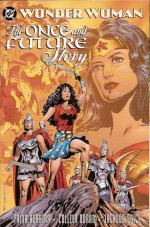
By Trina Robbins, Colleen Doran & Jackson Guice (DC Comics)
ISBN: 1-56389-373
Every so often the intention to do good generates an above average comics product such as this one-shot created to raise awareness of domestic violence. A hugely important issue, and one that far too many unfortunate children are sadly aware of from an early age, it is also one of the oldest “relevant†topics in comic book history: Superman memorably dealt rough justice to a “wife-beater†in his very first adventure (Action Comics #1, June 1938).
Less visceral, but far more even-handed, is this beautiful, subtle tale-within-a-tale from Trina Robbins, illustrated by Colleen Doran and Jackson Guice. Wonder Woman is summoned to an archeological dig in Ireland by a husband and wife team to verify the finding of a 3000 year old tomb that contains the body and burial trappings of a princess from the fabled island of Themyscira.
As Wonder Woman translates the scrolls detailing the story of Princess Artemis of Ephesus, daughter of Queen Alcippe, who was taken as a slave by the Greek hero Theseus, she slowly realizes that the animosity of dig-chief James Kennealy is perhaps more than professional jealousy, and that his wife’s Moira’s defensive attitude and constant apologies mask a dark secret. Artemis’s brutal, painful quest to rescue her mother mirrors Moira’s journey to awareness as both women, separated by three millennia, take control of their so different, tragically similar lives.
Challenging, powerful but still wonderfully entertaining, this is a tale both worthy and worthwhile.
© 1998 DC Comics. All Rights Reserved.
The Best of GI Joe
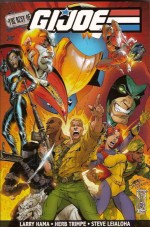
By Larry Hama & various (Panini Books UK)
ISBN: 9787-1-84653-425-6
The torrent of material tying in to the blockbuster move (see GI Joe: the Rise of Cobra Official Movie Prequel and GI Joe: Snake in the Grass) continues with this very welcome compendium collecting some of the most impressive highlights of Marvel’s output: a hugely successful mini-franchise that encompassed three regular titles plus many specials at one stage.
I’ve no real interest in the film, but the toy, cartoon and comics phenomenon reached way more impressionable minds that most modern comics could even imagine and many of the strip adventures (both US and Marvel UK’s) were highpoints of sequential narrative at a time when innovation and imagination were highly regarded – and rewarded – so it’s great to see some of them finding a fresh audience.
In case you came in late: GI Joe is the operating name for an American covert, multi-disciplinary espionage and military intervention force that draws its members from all branches of the services. At the time of these tales the Joes and terrorist secret society Cobra are well known to each other and engaged in a full-on clandestine global war…
The collection begins with the ultimate “classic Joe†story; a magnificent example of disciplined storytelling from Larry Hama who wrote all the tales in this volume, and laid out this sharp tale of Yankee ninja Snake-Eyes rescuing operative Scarlett from Cobra captivity. Originally published in GI Joe #21, ‘Silent Interlude’ was embellished by Steve Leialoha, and tells a riveting action-packed yarn without ever using dialogue or captions.
This is followed by a more traditional, but no less impressive yarn from issue #24. Illustrated by the legendary Russ Heath, ‘The Commander Escapes!’ sees a small team of Joes attempting to keep Cobra’s leader captive, with all their enemy’s vast resources arrayed against them, and in #26 Leialoha returned for ‘Snake-Eyes: the Origin’, a complex Vietnam saga that barely scratches the surface of a long-running mystery…
‘Shakedown!’ (GI Joe #34), with art from Rod Whigham and Andy Mushynsky, is a cracking tale of ultra-modern jet dogfighter that would make Hans von Hammer proud whilst ‘Going Under’ from #63, (by Ron Wagner and Mushynsky) finds a select team undercover and facing the Soviet analogues of Borovia in an attempt to rescue Joes held in an infamous Gulag. Regrettably it’s the middle of a much longer epic and impressive though it is, there’s no resolution to be had for new readers.
Hama successfully reprised Silent Interlude in #85’s ‘SFX’, with Paul Ryan illustrating a classy, high body-count ninja tale featuring Snake-Eyes’ polar opposite Storm Shadow, and issue #86 celebrated the 25th anniversary of the original toy’s release (we called him Action Man in the UK) with the excellent Marshall Rogers and Randy Emberlin depicting ‘…Not Fade Away!’ – where the team meet the original “Real American Hero†when Cobra commandos seize New York landmark…
The superb Tony Salmons pencilled ‘No Simple Solutions’ (#91) with Emberlin inks, a engrossing yarn detailing a duel between genius of disguise Zartan and the martial arts marvel Blind Master; a cracking fight issue, but as a component of the hugely extended Snake-Eyes origin, the unresolved sub-plots are a little confusing in places…
‘Hero of the People!’ from #104 (with art from Mark Bright and Emberlin) finds Snake-Eyes in Borovia as the country reels under an anti-communist revolution: another epic with no conclusion in this volume, but at least the book ends on a classy mote with the complete story ‘All in a Night’s Work’ (art by Herb Trimpe and Mushynsky) from GI Joe Special Missions #17 as Stalker leads a covert team on a simple rescue mission against terrorists only to discover he’s been set up to take a fall by elements of his own government…
I’m never sure of the social value of stories where secret government operatives act beyond the law or the constraints of Due Process but the kid in me adores the pure satisfying simplicity of seeing a wrong and righting it: so on those terms this book of clever, witty action-packed adventures of honourable warriors doing their job is a delight worth sharing. Won’t you have some…?
© 2009 Hasbro. All Rights Reserved.
Stories of the West Book 1: Three Women at the Frontier
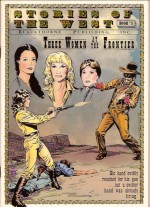
By Paulo Eleuteri-Serpieri, translated by Alfred Blomgren & Tony Raiola (Marvel)
ISBN: 0-932629-03-2
Paulo Eleuteri-Serpieri was born in Venice on February 29th 1944, and studied painting and architecture at the Fine Art Academy in Rome, graduating in 1966. He became an acclaimed painter before turning to comics in 1975 with historical dramas of the American West, scripted by Raffaele Ambrosio, which were published in Lancio Story and Skorpio as well as illustrating biblical tales in Découvrir la Bible.
From 1980 he turned to science fiction material for L’Eternauta, Il Fumetto and Orient-Express, before creating his landmark signature character Druuna, whose Junoesque proportions and fantastic adventures have captivated readers all over the world in such classics of pulchritudinous fantasy as Morbus Gravis, Creatura, Carnivora, Mandragora, Aphrodisia, Obsession, Druuna X and Croquis.
In Europe, where such superlatives are cherished, Serpieri’s astonishing ability to capture the female form in line and in colour has won him the title (although who else would want it is moot) of “Master of the Ass”, and this rare American translation of some of those early Western sagas certainly has a few beautiful nudes within its pages, but these two stories are worth looking at for more than that.
The eponymous ‘Three Women at the Frontier’ details the journey of a group of women literally exported to edge of American Civilisation at the close of the 19th century and how they wrested control of their lives and destinies from the callous, patronising men who thought they knew best, whilst ‘John and Mary, Mary and John’ details the unique meeting and budding relationship of a grizzled old mountain man and a wild woman hermit, once a squaw and slave; certainly one of the most intriguing and refreshing romances I’ve ever read.
Quirky, compelling and superbly underplayed, with some of the best drawing you’ll ever see, this is a fabulous lost treasure, only slightly marred by its appalling reproduction and too-casual proofreading. These wonderful tales of the west (and all those others untranslated as yet) are desperately in need of a high quality English language edition, but until then this will have to suffice…
© 1985 Paulo Eleuteri-Serpieri. All rights reserved.
Cyclops: Retribution
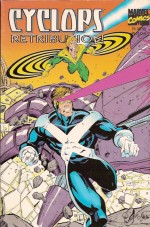
By Bob Harras, Ron Lim, Jeff Albrecht, Carol Reim & Bruce Patterson (Marvel)
No ISBN
Do you love every TV show you watch? Do you carry on with series, soaps and serials long after they’ve started to pall? Most of us do – especially in comics. The time invested in favourite characters and scenarios is non-returnable and any relationships you’ve developed with even fictional persons and places – ones utterly unaware of your existence – are terribly hard to abandon.
And in comics there’s always the possibility that a mediocre or sub-par tale will one day be pivotal to something brilliant that you will adore and appreciate. So your continued consumption perforce becomes an investment in good times to come…
Which isn’t to say that this solo adventure (at least that’s how it starts) of quintessential X-Man Cyclops is utterly dire, but that it’s just an average mutant superhero yarn adequately produced for the dedicated consumer: a fillip for the faithful but no breakthrough phenomenon that will convert the unread masses or summon home all those wayward apostates who have stopped collecting funny-books.
Originally presented as the lead strip in the fortnightly anthology Marvel Comics Presents #17-24 (following stellar runs starring Wolverine and Colossus respectively) this tale sees the leader of X-Factor – as he then was – visiting the Scottish island where Moira MacTaggert runs a medical research facility for mutants, only to discover that the somnambulistic medic has been creating bio-weapons at the hypnotic behest of seemingly unkillable menace the Master Mold.
This amalgam of human xenophobe Scott Lang and a super-Sentinel has plans to eradicate mutantkind, but may have overplayed his hand by extracting his conscience and giving it a body of its own…
Intriguing concept, enthusiastic art and lots of action make this so close to a memorable outing that it’s only fair to err on the side of generosity: not as bad as I remembered and certainly worth a moment of any X-Fan’s time and budget…
© 1994 Marvel Entertainment Group. All rights reserved.
Black Jack volume 6

By Osamu Tezuka translated by Camelia Nieh (Vertical)
ISBN: 978-1-934287-56-9
Equally able to speak to the hearts and minds of children and adults, Osamu Tezuka’s work ranges from the charming to the disturbing, even terrifying. In 1973 he turned his storyteller’s eye to the realm of medicine and created Burakku Jakku, a lone wolf surgeon living beyond society’s boundaries and rules: a scarred, seemingly heartless mercenary working miracles for the right price yet still a deeply human wounded soul who works his surgical wizardry from behind icy walls of cool indifference and casual hostility…
Born in Qsaka Prefecture on 3rd November 1928, Tezuka suffered from a childhood illness that made his arms swell. Inspired by the doctor who cured him to study medicine, he started his cartooning career at university, and although qualified as a doctor, when faced with a career crossroads, he followed his mother’s advice to do the thing that made him happiest. He never practiced medicine but the world gained such classic cartoon masterpieces as Tetsuwan Atomu (Astro-boy), Kimba the White Lion, Buddha, Adolf and literally hundreds of other graphic narratives. Along the way Tezuka incidentally pioneered, if not created, the Japanese anime industry.
One thing should always be remembered when reading these stories: despite all the scientific detail, all the frighteningly accurate terminology and trappings, Black Jack isn’t medical fiction; it is an exploration of morality with medicine raised to the level of magic… or perhaps duelling.
This is an epic of personal combats, a lone gunfighter battling hugely oppressive counter-forces (the Law, the System, himself) to win just one more victory: medicine as mythology, won by a Ronin with a Gladstone bag. Elements of rationalism, science-fiction, kitchen sink drama, spiritualism and even the supernatural appear in this saga of Magical Realism that rivals the works of Fuentes and Gabriel GarcÃa Márquez. But overall these are dramatic, highly addictive comics tales of heroism; and ones that that will stay with you forever.
The long overdue series of translated, collected adventures continues in this sixth volume with the bittersweet ‘Downpour’ as Black Jack finds himself trapped on an impoverished island helping a dedicated young doctor, fighting local government corruption and an epidemic, whilst in ‘A Body Turned to Stone’ morality and ethics war with base humanity and smug, religious complacency resulting in an uncommon tragedy.
There’s a message of hope in ‘The Old Man and the Tree’ as a desperate octogenarian battles City Hall to save his oldest friend from demolition, whilst in ‘Twice Dead’ the super-surgeon is called upon to save a criminal suicide so that the state can execute him, and compelled to invent an impossible cure or be imprisoned for practising medicine without a license in ‘Lion-Face Disease’.
The medical profession is held up to harsh scrutiny in ‘Con Man, Aspiring’ when a poor man, at the behest of a scheming doctor, deliberately writes Black Jack a cheque he cannot honour, whilst a rich Texan faces some unpleasant home truths when the surgical Ronin attempts to cure his son of ‘Brachydactyly’. ‘Amidst Fire and Ashes’ sees Black Jack reunite a father and son when he performs delicate surgery under an erupting volcano, ‘Revenge’ sees him outwit the united Medical Board of Japan when they put their wishes before the needs of a patient and even take on the Japanese railway system itself in the poignant yet heart-warming ‘Vibration’.
We enter the realm of pure science fiction as an animal experiment goes incredibly awry in ‘Nadare’ before seeing Black Jack outwit death whilst trapped in a elevator at the bottom of a collapsed building in ‘Three in a Box’, masquerade as one of his greatest rivals in ‘The Substitute’ and in ‘Terror Virus’ – the final tale of this tome – join old foe the euthanizing Dr. Kiriko when the Government embroils them both in a sordid, clandestine scheme involving stolen bio-weapons. As usual Black Jack has the final word…
Thrilling, heart-warming, bitterly insightful and utterly addictive, these incredible stories of a medical wizard in a crass, mundane and hostile world will blow your mind and all your preconceptions of what storytelling can be…
This book is printed in the Japanese right to left, back to front format.
© 2009 by Tezuka Productions. Translation © 2009 by Camelia Nieh and Vertical, Inc. All Rights Reserved.
